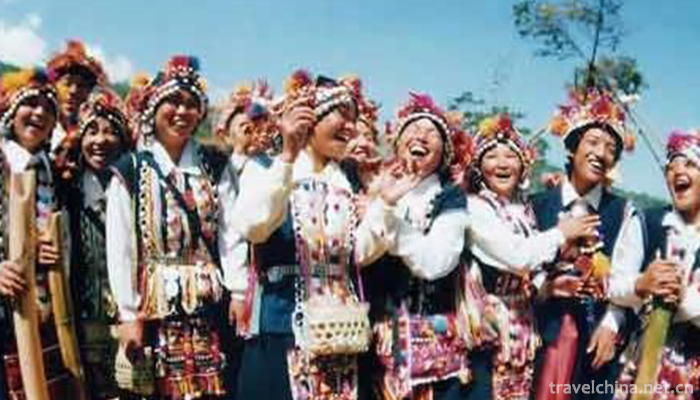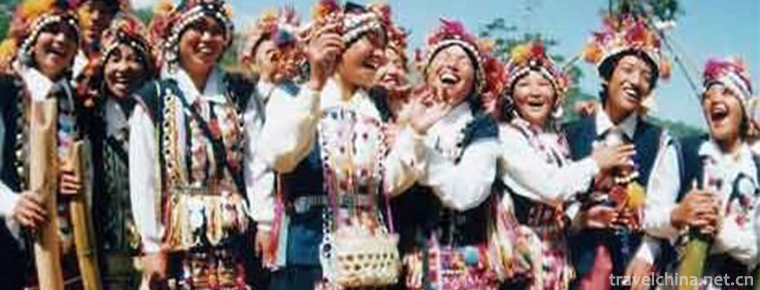Multi voice Folk Songs of Hani Nationality
Multi voice Folk Songs of Hani Nationality
Hani multi-voice folk songs are popular in several Hani villages in the eastern part of Azahe Township, Honghe County, with Puchun Village as the center. Their natural environment is closed and traffic is inconvenient. Historically, they have been the jurisdiction of the chief slag officer. The single ethnic distribution pattern and the political and historical background of the Tusi regime's long-term rule have prevented the foreign heterogeneous cultures from penetrating into the Puchun area, so that the original ecological traditional cultures such as Hani multi-voice music can be systematically preserved. This folk song is generally divided into two types: instrumental accompaniment and non-instrumental accompaniment. The singing content is based on the original "Yangyang Mountain Song", while the other "Orchid Tower" and "Love Song" are attached. Compared with other Hani folk songs, the multi-voice folk songs have both generality and individuality.
On May 20, 2006, Hani multi-voice folk songs were listed in the first batch of national intangible cultural heritage list with the approval of the State Council.
historical origin
Hani multi-voice folk songs are popular in several Hani villages in the eastern part of Azahe Township, Honghe County, with Puchun Village as the center. Their natural environment is closed and traffic is inconvenient. Historically, they have been the jurisdiction of the chief slag officer.
artistic characteristics
The multi-voice folk songs of the Hani nationality include the praise of labor, love and the beautiful scenery of the countryside. The way of singing can be divided into two types: instrumental accompaniment and vocal assistant tune without instrumental accompaniment. Hani multi-voice folk song singing occasions are diverse, terraces, mountains and villages can be its performance space. The accompaniment instruments are all made by folk singers themselves, and the three strings and the small erhu are only used in Puchun Village. The Lyric structure of multi-voice folk songs of Hani nationality consists of three parts: opening words, theme words and helping words. Its musical form shows distinct national and regional characteristics in terms of syllable structure, mode sequence, mode color, mode combination and multi-voice part composition.
Representative works
There are "My Place Az" (planting Yangshan Song) and "Love Song" and so on.
Inheritance value
The multi-voice folk songs of the Hani nationality embody the musical wisdom and talent of the Hani nationality, and show the unique singing talent of the Hani nationality. During the field investigation, experts have collected eight original forms of Hani multi-voice folk songs, which are extremely rare and of high historical, scientific and artistic value. Hani multi-voice folk song is the treasure of Chinese national music, which has attracted wide attention from the music circles at home and abroad. Hani multi-voice folk songs and social production, especially accompanied by terraced rice farming, are important materials for the study of Hani culture and its national character and aesthetic concept.
The multi-voice folk songs of Hani nationality are deeply hidden in the hinterland of Ailaoshan Mountains. Their inheritance is totally dependent on folk singers. Although it has attracted wide attention from experts in music and anthropology, they have not been protected systematically and systematically for a long time. The number of inheritors with comprehensive quality of multi-voice music is decreasing day by day. This valuable folk music form is on the verge of losing its inheritance.
The state attaches great importance to the protection of intangible cultural heritage. On May 20, 2006, Hani multi-voice folk songs were approved by the State Council and listed in the first batch of national intangible cultural heritage list.


-
1.Dameisha Beach Park
Dameisha Beach Park was built on June 18, 1999 with a total investment of 120 million yuan
Time 2018-10-12 -
2.Qinghai Tibetan Medicine Culture Museum
Qinghai Tibetan Medicine and Culture Museum was built in 2006, with a total construction area of 12,000 square meters. It is the only comprehensive museum reflecting
Time 2019-02-07 -
3.Badang dance
Badang Dance is a kind of ancient folk dance, which originated from the ancient Qiang people's "Temple Festival" in Dingxi Minxian, southeastern Gansu Province. It is also a sacrificial ritu
Time 2019-04-02 -
4.Rice custom
Wannian rice custom and Shangrao Wannian County custom are cultural heritage. Wannian is the "land of rice". The traditional rice custom has been passed down in this area for thousands of ye
Time 2019-04-26 -
5.Fuzhou bodiless lacquerware decoration skills
Fuzhou bodiless lacquerware decoration technology, Fuzhou, Fujian Province, local traditional handicraft, one of the national intangible cultural heritage.
Time 2019-04-30 -
6.Drum bowl song
Drum-pot song is a very ancient traditional form of music and art in Hubei Province of China. It originates from the traditional folk activities of "beating a pot as a drum, singing with the fune
Time 2019-05-01 -
7.Huangzhong embroidery
Huangzhong heap embroidery is a kind of art that uses the techniques of "shearing" and "heap" to create images. It is mostly used in Tangka production, with Tibetan Buddhist themes
Time 2019-05-04 -
8.Leting drum
Music Pavilion Drum is a representative form of traditional music drum book and drum music in northern China. It is widely spread in eastern Hebei, Beijing, Tianjin and northeastern Liaoning, Jilin, H
Time 2019-05-11 -
9.Legend of Liu Yi
The legend of Liu Yi's biography is one of the oldest popular folklores in Chinese history. With Liang Zhu, Tianxian Pair and White Snake Legend, they are called the four legends of Chinese folklore.
Time 2019-05-14 -
10.Flyover wrestling
In the 1930s, when Peiping wrestling was very popular, Peiping wrestling was famous all over the country. At that time, the strongest wrestling master of Peiping overpass was Shen San (Shen Yousan), B
Time 2019-06-21 -
11.Turkish Pan Embroidery
Pan embroidery is the most important embroidery method in Chinese Tu embroidery, and it is a compulsory course for Tu women in their lifetime. Pan embroidery is a unique embroidery method of the Tu na
Time 2019-06-23 -
12.Ban Gu
Ban Gu (32 - 92 years), Meng Jian, Fufeng An Ling (now Shaanxi Xianyang Northeast China, famous in Eastern Han Dynasty historian , Litterateur 。 Ban Gu's birth Confucianism Family, father Ban Bi Uncle
Time 2019-09-06